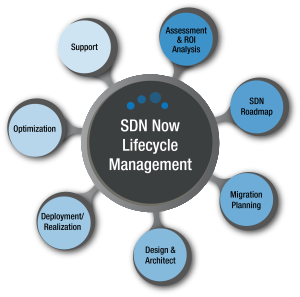SDN Now Lifecycle Management
Enhance Network Agility, Scalability And Speed
With Datavision SDN Now Lifecycle Management, we help you navigate the complexities of implementing SDN into your network infrastructure.
Our end-to-end process ensures that you reduce your capital and operational expenses while enhancing your network with agility, scalability and speed. It covers every stage of the process, from defining your business objectives to post-implementation support.
 SDN Now Lifecycle Management provides unprecedented programmability, automation and network control. By evolving beyond conventional hierarchical network structure, users get faster access, and network support teams are free to make changes in significantly less time than current approaches.
SDN Now Lifecycle Management provides unprecedented programmability, automation and network control. By evolving beyond conventional hierarchical network structure, users get faster access, and network support teams are free to make changes in significantly less time than current approaches.
SDN Now Lifecycle Management also provides network agility, ensuring maximum throughput and the ability to centrally make changes to network appliances to meet user demands and achieve unprecedented scalability. Network agility enables easy configuration changes without the need to manage on a device level, while allowing the agility to quickly and easily adjust security protocols and enforce universal policy guidelines.
Datavision SDN Now Lifecycle Management includes these specific steps:
Assessment And ROI Analysis
With SDN Now Lifecycle Management, we start by identifying all use cases that present a valid reason to apply SDN and Network Functions Virtualization (NFV) to your existing infrastructure. A Proof-of-Concept (POC) is developed along with smaller initial projects to prove out the technology and methodically introduce it into the network. This can be followed by an SDN roadmap for anything from another SDN project to a rollout to the entire network.
SDN Roadmap
Once the use cases are identified, the next step is designing a network solution architecture that addresses each relevant use case.
The POC stage is critical for the deployment of any new network technology. The POC is based on an identified use case that is highly controllable and has few moving parts. Datavision’s QuickStart lab gives you a test environment that makes it quick and efficient to test your proposed SDN in a real-file simulation. The POC is executed quickly with the key objective to test and verify the concept that open standards and a models-based approach reduce the need for additional customization.
Operational processes to manage the network from day-to-day are also defined. We assess SDN implementation based on your network dependencies and what process change requirements are needed to implement the software-defined network moving forward.
Migration Planning
SDN implementation is an ongoing process, requiring a determination of how to integrate the technology while still leveraging your existing network investment. It isn’t like setting up a new department where you’re just adding onto your existing network. With SDN, you’re looking at a new view of how the network operates.
Datavision works with you to create a migration plan that allows you to seamlessly integrate SDN without disrupting your existing network.
Due to the increasing rate at which new products and technologies are being introduced in the field, companies like Datavision can also add much to the evaluation and vetting process of all the vendors by providing expertise, benchmarking and resources as you migrate to an SDN-centric infrastructure.
Design And Architect
Datavision helps create, design and architect an SDN configured for your unique network requirements using industry best practices developed by our experienced networking team.
The design of SDN network architecture comprises three layers that are accessible through open APIs. The goal of this design is to provide open interfaces that enable the development of software to control the connectivity and flow of traffic through network devices.
Software functionality also controls the SDN network, regardless of software vendor, further enabling automation of the network. Applications interact with the network through open APIs, eliminating the need for developers to write support for proprietary hardware and software.
Deployment And Realization
As with any infrastructure upgrade, the deployment of SDN requires a detailed implementation plan with a timeline for specific phases of the deployment. The timeline should allow for the development of any new software applications in advance and plan for configuration and optimization of these applications once SDN is deployed.
We ensure that we maintain clear and open communication throughout the project, and that coordination between the development and production environments is established and rigorously maintained.
Optimization
Cost reductions vary across businesses, but the first goal should be to capture measurable savings on operational and infrastructure costs. Optimization of virtualized appliances is the key in lowering CapEx and OpEx.
Datavision helps establish a clear set of metrics to measure cost savings. Ongoing measurement and analysis of these metrics helps guide the ongoing network optimization process.
The high level and comparative ease of programmability of an SDN infrastructure leads to a lower network operating cost. Dozens of man-hours previously spent on hand-coding hardware are eliminated and the increased speed of an SDN-enabled network allows for new network services to be launched quicker, which could speed up revenue streams.
Support
Training is essential in getting — and keeping — your IT team up to speed with SDN, and we offer several ways to learn.
Whether supplementing an existing IT team or providing full end-to-end solutions, Datavision has the resources to be a valuable partner in keeping SDN optimized and helping you realize lower CapEx and OpEx.
Ready to start your SDN journey? Contact us to see how our SDN Now Lifecycle Management can transform your organization’s networks.
Latest Blog Posts
- SD-WAN & SASE: Secure your network and your information at the Edge
- Protecting Your Information and Your Organization with SD-WAN and SASE
- Datavision uCPE/SD-WAN Reference Solution at MEF18 (and Beyond!)
- The Advent of NFV and Best Practices for Deployment
- ONAP’s Great Potential: What It Means for Service Providers, Vendors & Enterprises






